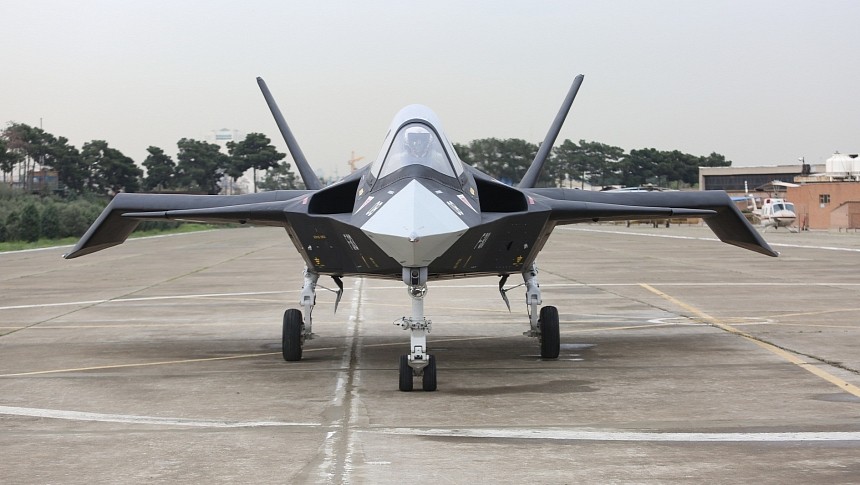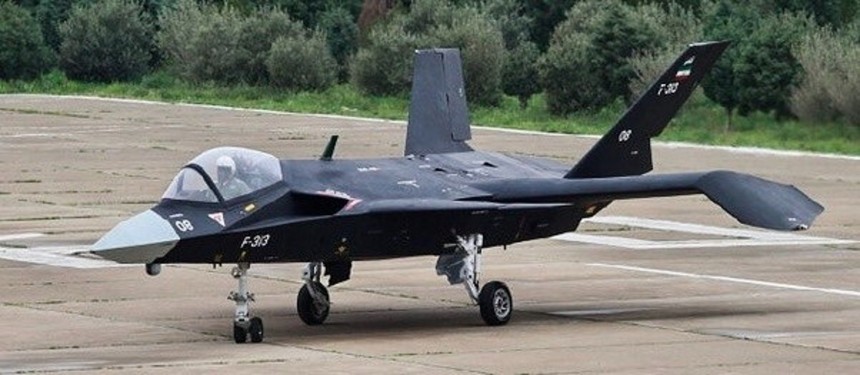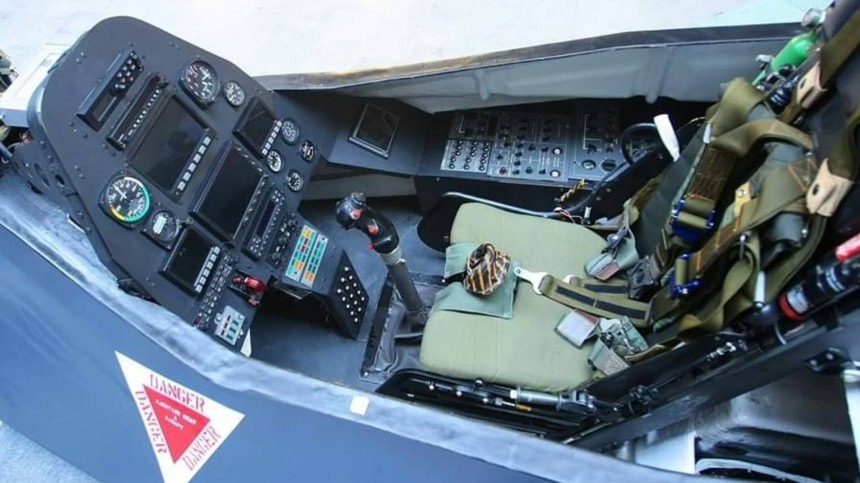It's easy to get the wrong idea about Iran. But make no mistake. The IAIO Qaher 313 stealth fighter prototype represents everything wrong with modern Iran. This is the full story around Iran's lame-duck stealth fighter.
But to understand how Iran wound up fending for itself in military aviation technology, we need to go back to a time before the Iranian Government was ideologically opposed to the West. In fact, from the mid-1920s until the Iranian Revolution of 1979, the Imperial State of Iran and Western powers like Britain, France, and the United States were positively chummy with one another. Under the rule of Mohammad Reza Pahlavi, the final Shah of Iran, this cozy relationship with the U.S. Military, in particular, began paying real dividends.
Perhaps the first American jet fighter to wear Iranian Air Force roundels was the Northrop F-5 Freedom fighter. A fast, agile, twin-engine light fighter built to tussle with Soviet MiGs, the F-5 could have formed the backbone of the entire Imperial Iranian Air Force had it not been for the two other American jets sold to the IIAF. These would, of course, be the McDonnell-Douglas F-4 Phantom II, and the state-of-the-art, swing-wing Grumman F-14 Tomcat. For the next 40 years, this consortium of American hardware formed the cornerstone of one of the most powerful Air Forces in the Middle East.
But there was a big problem. With the fall of the Pahlavi dynasty in the Iranian Revolution of 1979, so too did any semblance of a partnership between the Pentagon and Tehran go up in smoke. Suddenly, a liberal dose of espionage was the only avenue Iran could use to acquire spare parts for its fleet of American jets. It's widely believed an attempt to quell Iranian espionage led to the F-14's premature retirement from U.S. Navy service in 2006. By this time, American F-22 Raptors had already entered service, with Russian and Chinese responses in the Sukhoi Su-57 and Chengdu J-20 following in the coming decade.
So what's a cash-strapped pariah state in the Middle East supposed to do to get a leg up in the stealth fighter game? They could always call on their supposed allies in Russia and China to help expedite the process. But no, Iran's gen-V stealth fighter was to be a wholly in-house design under the supervision of Iranian-state assets. A joint partnership between the Iran Aircraft Manufacturing Industries Corporation (HESA) and Iran Aircraft Industries (SAHA) was in charge of designing this novel jet fighter, soon to be dubbed the IAIO Qaher-313 (F-313). Should the prototype ever reach production, it would be overseen by the state-asset Iran Aviation Industries Organization (IAIO).
The static mockup for the design was unveiled in front of the Iranian state media in 2013, with key Iranian Military leaders like the Commander of the Islamic Republic of Iran Air Force (IRIAF), Brigadier General Hassan Shah-Safi, being present to watch the F-313 make its global debut. Though official records regarding the dimensions of this novel airplane haven't been released, it's fair to say the F-313 is considerably smaller than an F-22 or even an F-35. In some ways, the F-313 resembles a strange chimera of both American Gen-V stealth fighters.
Such a design would have been great in, say, a video game. But Iranian media at the time seemed to swear by the F-313's real-world prowess and stealth capability during its global debut. Proudly declaring the jet's radar-absorbent coating and specially designed air inlets prevent the jet from being identified on radar at service altitudes. As for what could power this novel jet? That's another point of contention for Western journalists trying to make sense of Iran's new fighter. It's possible for Iran to cannibalize engines from their fleet of American F-4s, F-5s, and F-14s to power a new era of stealth fighters. But it's more likely that Iran planned to use Chinese, Russian, or even their own domestically produced engines like the TEM Toloue-5 turbojet to propel the F-313.
In terms of weaponry, it's believed that Iran planned to use Chinese license-built copies of the Russian Vympel R-77 long-range, air-to-air missile, roughly the equivalent to the American AIM-120 AMRAAM as its primary aerial armament alongside ground attack load-outs carrying two 2,000 lb (910 kg) smart bombs. According to Iranian State media, the F-313's airframe is so stable in flight that it lacks the need for a complex and expensive fly-by-wire system, relying on old-fashioned cables and linkages to maneuver the jet through the air. Yeah, we'll need to see some receipts about all of that.
It's not known what form of engine the F-313 prototype used during taxi testing in April 2017. But what is known, despite these tests occurring nearly eight years ago, is that the F-313 has still yet to have its first test flight. This has led many important media figures in the West, primarily from Israel, to declare the F-313 a "hoax." The undoubtedly civilian nature of the avionics inside the jet's cockpit hasn't done anything to quell doubts about the plane's validity. Nor did the apparent lack of an internal weapons bay stop Western observers from shouting from the rooftops that the F-313 probably isn't even stealthy.
Finally, ten years after its initial unveiling in February 2023, it was announced by IAIO that the F-313 program would be reorganized into an unmanned stealth drone before it'd even had its first human-crewed test flight. In all but saying so directly, this appeared to be an admission of defeat on the part of the Iranians to field their own domestic stealth fighter. Meanwhile, Iran's new target date for the now un-crewed UAV based on the F-313 is set for the middle of 2024. Whether this test flight will come to pass on time, if at all, is anybody's guess.
But what isn't up for debate at all is the questionable integrity of the F-313's design team; it leaves a lot to be desired. Therefore, any ostensible advances in the new UAV's design program will have to be taken with a few grains of salt, if not an entire salt lick. More to the point, with Iran actively supplying Russia with weapons in its disastrous ongoing invasion of Ukraine, it's clear Iranian aero engineers have other concerns beyond their own domestic fighter program to contend with. So, will the F-313, crewed or un-crewed, ever get off the ground at all? Well, we have our doubts for reasons that should be obvious by now.
At this stage, it's hard to tell whether Iran will retire its fleet of American jet fighters before its first stealth plane even makes its first flight. But what do you all think? Could the Iranians really be onto something? Or is the F-313 a piece of vaporware rivaled only by the Russian Su-75? We have a pretty decent idea of what the response is liable to be. But let us know in the comments down below. But seriously, come on. The thing looks like it was built in an Ace Combat video game.
Perhaps the first American jet fighter to wear Iranian Air Force roundels was the Northrop F-5 Freedom fighter. A fast, agile, twin-engine light fighter built to tussle with Soviet MiGs, the F-5 could have formed the backbone of the entire Imperial Iranian Air Force had it not been for the two other American jets sold to the IIAF. These would, of course, be the McDonnell-Douglas F-4 Phantom II, and the state-of-the-art, swing-wing Grumman F-14 Tomcat. For the next 40 years, this consortium of American hardware formed the cornerstone of one of the most powerful Air Forces in the Middle East.
But there was a big problem. With the fall of the Pahlavi dynasty in the Iranian Revolution of 1979, so too did any semblance of a partnership between the Pentagon and Tehran go up in smoke. Suddenly, a liberal dose of espionage was the only avenue Iran could use to acquire spare parts for its fleet of American jets. It's widely believed an attempt to quell Iranian espionage led to the F-14's premature retirement from U.S. Navy service in 2006. By this time, American F-22 Raptors had already entered service, with Russian and Chinese responses in the Sukhoi Su-57 and Chengdu J-20 following in the coming decade.
So what's a cash-strapped pariah state in the Middle East supposed to do to get a leg up in the stealth fighter game? They could always call on their supposed allies in Russia and China to help expedite the process. But no, Iran's gen-V stealth fighter was to be a wholly in-house design under the supervision of Iranian-state assets. A joint partnership between the Iran Aircraft Manufacturing Industries Corporation (HESA) and Iran Aircraft Industries (SAHA) was in charge of designing this novel jet fighter, soon to be dubbed the IAIO Qaher-313 (F-313). Should the prototype ever reach production, it would be overseen by the state-asset Iran Aviation Industries Organization (IAIO).
Such a design would have been great in, say, a video game. But Iranian media at the time seemed to swear by the F-313's real-world prowess and stealth capability during its global debut. Proudly declaring the jet's radar-absorbent coating and specially designed air inlets prevent the jet from being identified on radar at service altitudes. As for what could power this novel jet? That's another point of contention for Western journalists trying to make sense of Iran's new fighter. It's possible for Iran to cannibalize engines from their fleet of American F-4s, F-5s, and F-14s to power a new era of stealth fighters. But it's more likely that Iran planned to use Chinese, Russian, or even their own domestically produced engines like the TEM Toloue-5 turbojet to propel the F-313.
In terms of weaponry, it's believed that Iran planned to use Chinese license-built copies of the Russian Vympel R-77 long-range, air-to-air missile, roughly the equivalent to the American AIM-120 AMRAAM as its primary aerial armament alongside ground attack load-outs carrying two 2,000 lb (910 kg) smart bombs. According to Iranian State media, the F-313's airframe is so stable in flight that it lacks the need for a complex and expensive fly-by-wire system, relying on old-fashioned cables and linkages to maneuver the jet through the air. Yeah, we'll need to see some receipts about all of that.
It's not known what form of engine the F-313 prototype used during taxi testing in April 2017. But what is known, despite these tests occurring nearly eight years ago, is that the F-313 has still yet to have its first test flight. This has led many important media figures in the West, primarily from Israel, to declare the F-313 a "hoax." The undoubtedly civilian nature of the avionics inside the jet's cockpit hasn't done anything to quell doubts about the plane's validity. Nor did the apparent lack of an internal weapons bay stop Western observers from shouting from the rooftops that the F-313 probably isn't even stealthy.
But what isn't up for debate at all is the questionable integrity of the F-313's design team; it leaves a lot to be desired. Therefore, any ostensible advances in the new UAV's design program will have to be taken with a few grains of salt, if not an entire salt lick. More to the point, with Iran actively supplying Russia with weapons in its disastrous ongoing invasion of Ukraine, it's clear Iranian aero engineers have other concerns beyond their own domestic fighter program to contend with. So, will the F-313, crewed or un-crewed, ever get off the ground at all? Well, we have our doubts for reasons that should be obvious by now.
At this stage, it's hard to tell whether Iran will retire its fleet of American jet fighters before its first stealth plane even makes its first flight. But what do you all think? Could the Iranians really be onto something? Or is the F-313 a piece of vaporware rivaled only by the Russian Su-75? We have a pretty decent idea of what the response is liable to be. But let us know in the comments down below. But seriously, come on. The thing looks like it was built in an Ace Combat video game.









